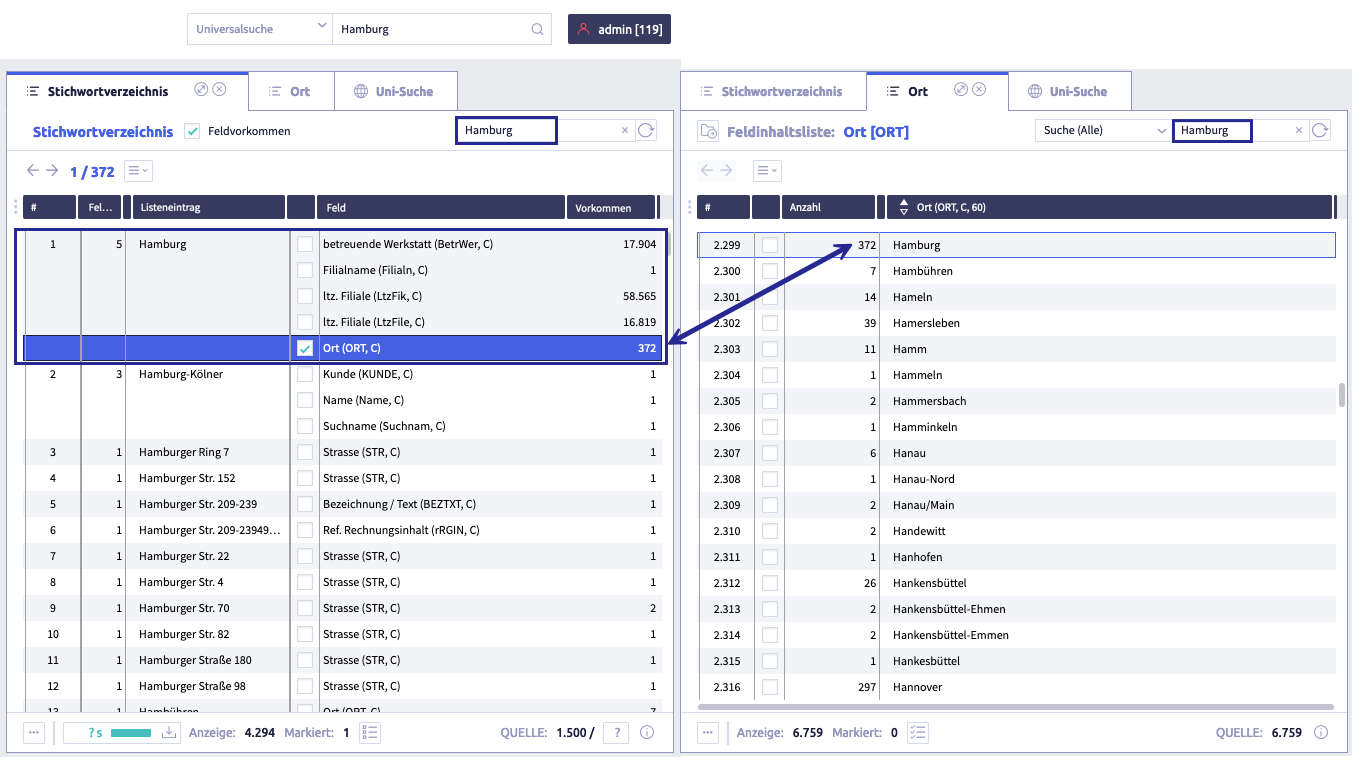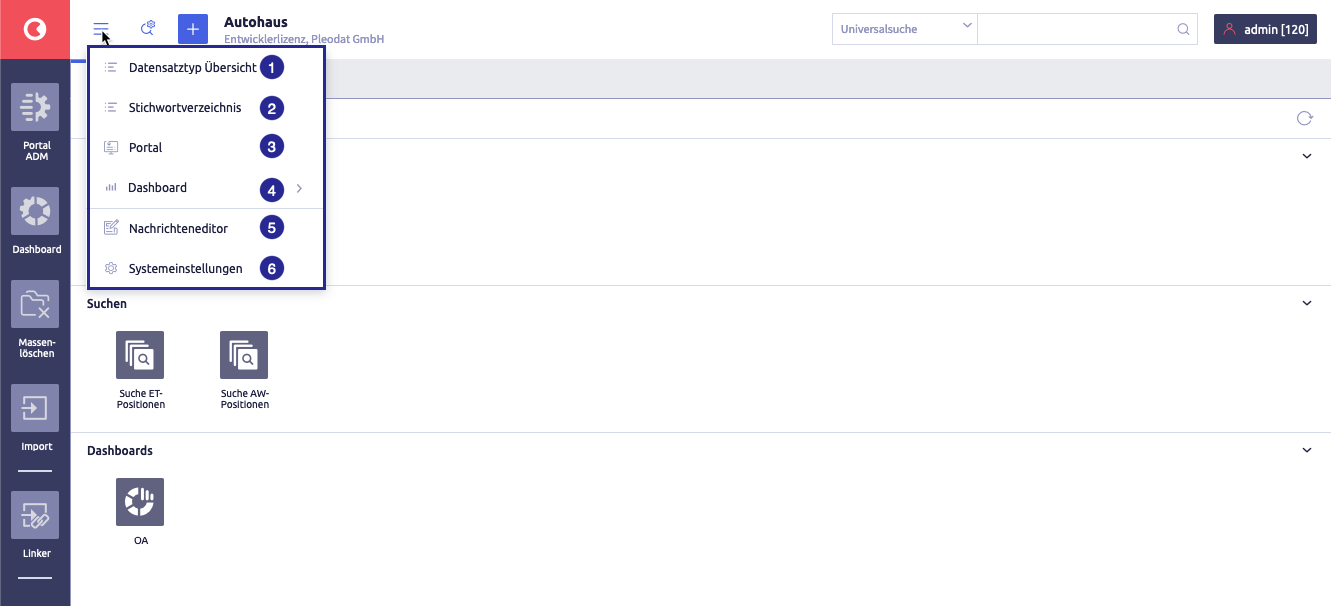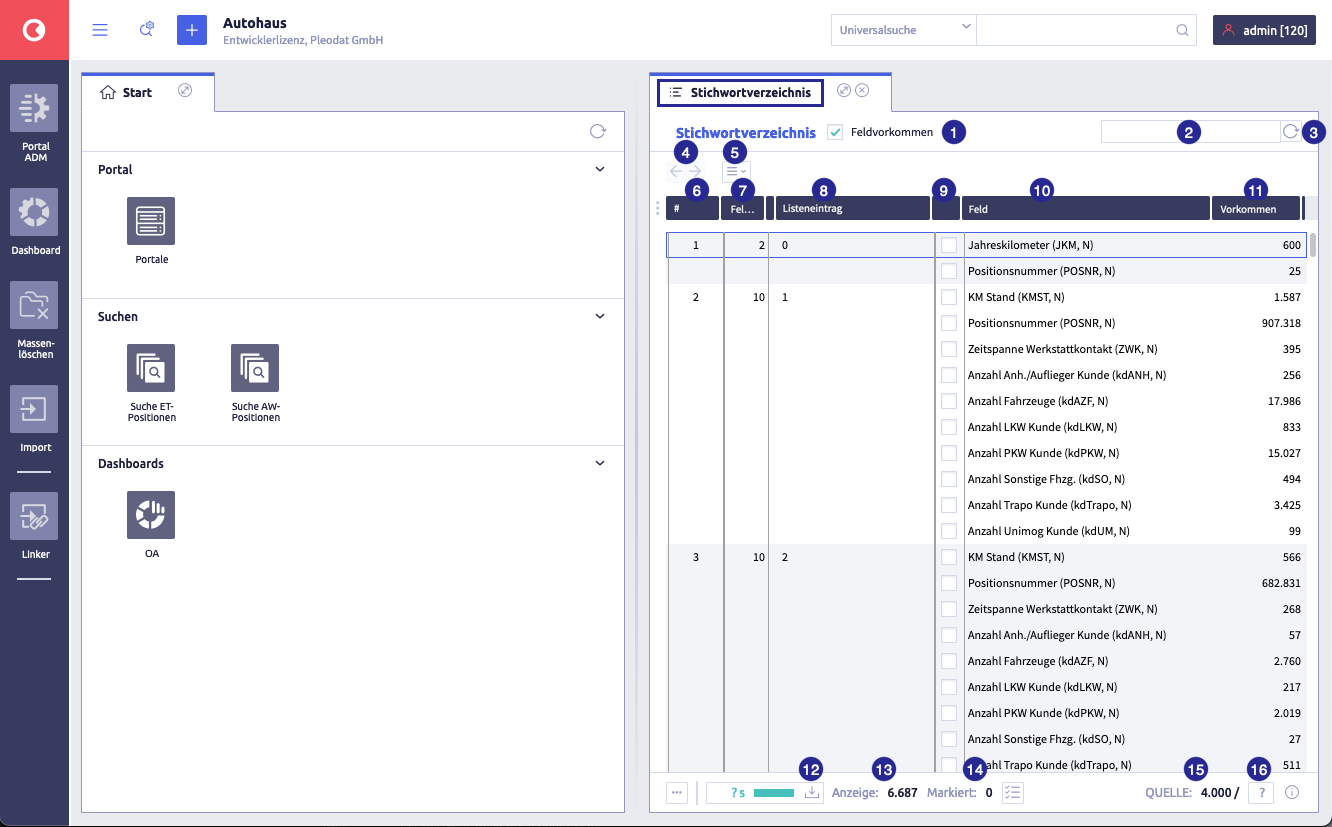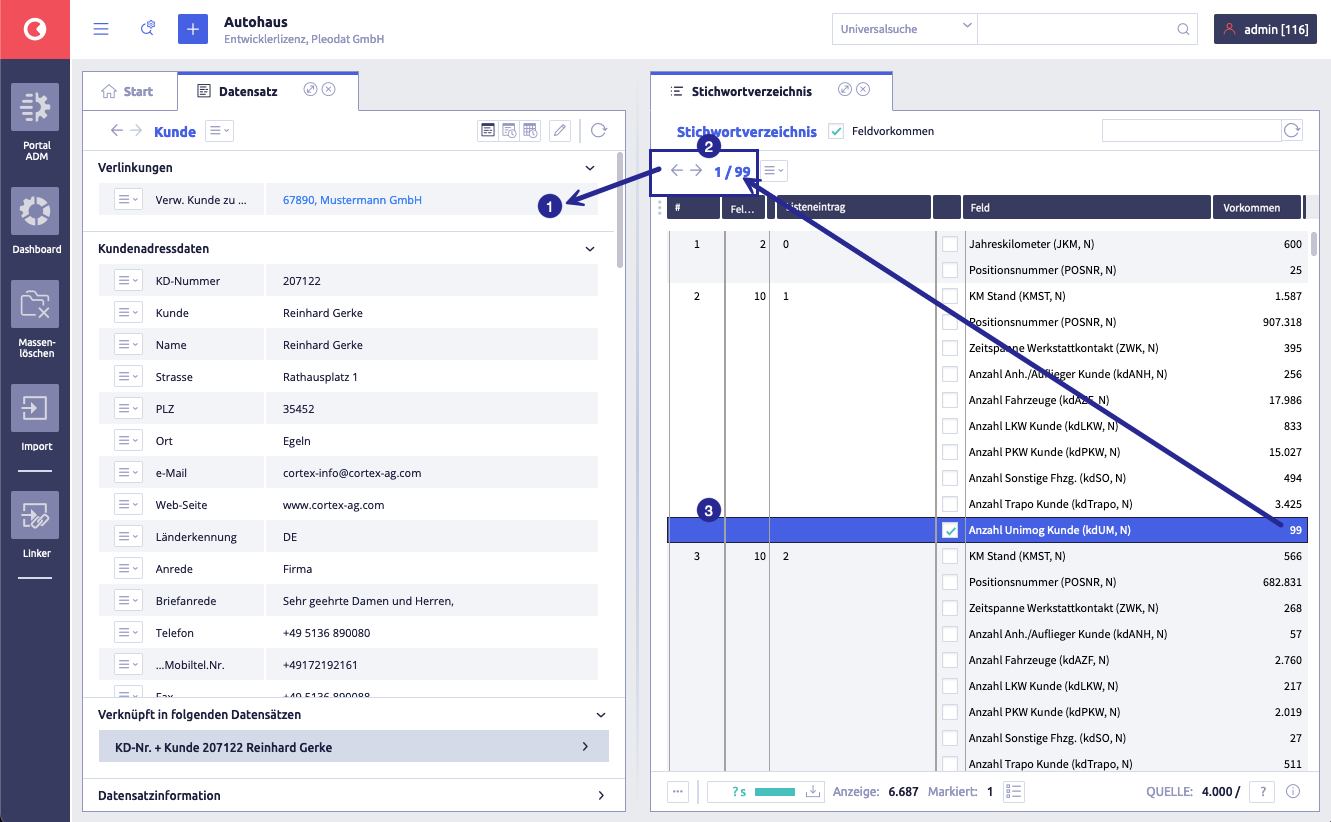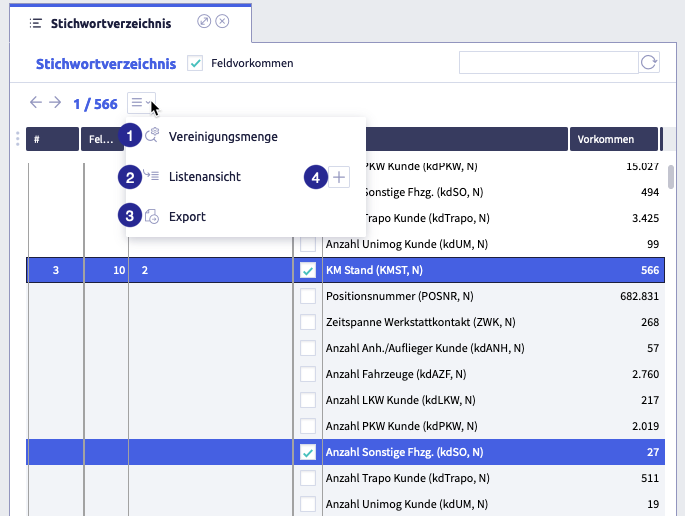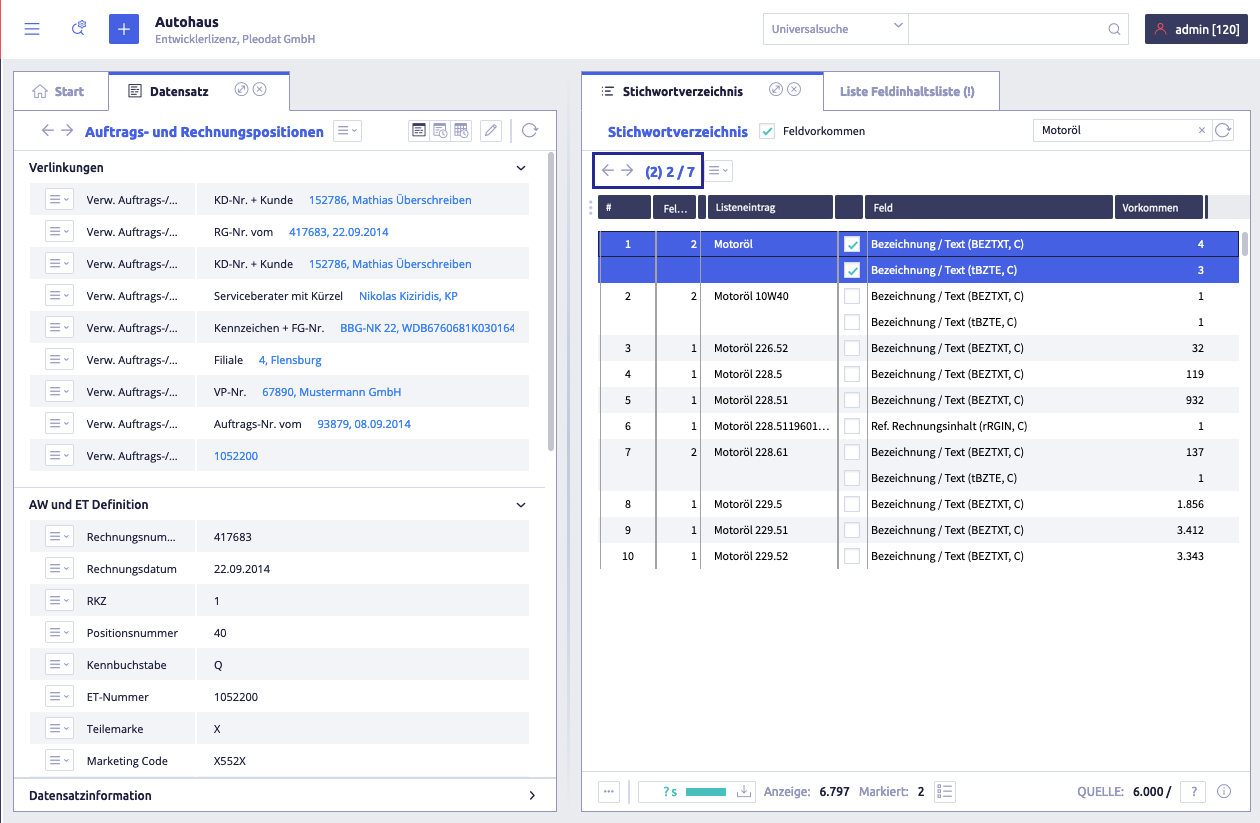Global dictionary¶
The global dictionary is a list in which the field contents of fields with a list entry are saved. For each field content, this list shows the occurrence and the fields that have this content.
In a field dictionary, all contents of a specific field and the respective occurrence are displayed as a list.
Comparison between global dictionary and field dictionary using the example of Hamburg
The global dictionary shows the occurrence of a content in all fields, the field dictionary shows all contents and their occurrence in a single field.
left: result in the global dictionary for the field content Hamburg. Line #1 contains five fields that contain exactly the character string Hamburg. The following rows contain field contents beginning with Hamburg. The list can be scrolled downwards, but not upwards.
right: field dictionary for the field City. The complete list with 6759 entries is opened. The top entry is the location used to open the list. The list can be scrolled up and down.
Field types with list entry
- character (C)
- positive integer (N)
- internal link (I)
- date (D)
- time (T)
The global dictionary can be accessed using the hamburger menu at the top left in the header of the user area.
Hamburger menu in the header
The image shows the selection under the hamburger menu: (1) record type overview, (2) global dictionary, (3) portal, (4) dashboard, (5) news editor, (6) system settings
An additional entry News is displayed as soon as news are available.
The opened global dictionary looks as follows:
The image shows all elements of the global directory: (1) checkbox Field occurrence, (2) search field, (3) button Refresh
, (4) navigation through records, (5) selection menu
for selected entries, (6) column row number, (7) column Fields, (8) column List entry, (9) column with checkboxes to select entries, (10) column Field , (11) column Occurrence , (12) button Load data , (13) information Display , (14) information Selected , (15) information Source , (16) information Total number
Table with all elements of the window Global dictionary
| Name | Meaning | Note |
|---|---|---|
| checkbox Field occurrence | ||
| search field for global dictionary | the entire data inventory is searched | for results, the search term must be entered correctly in upper and lower case |
| button Refresh | refresh field dictionary | |
| arrows for navigating through the records of a selected entry | ||
| selection menu for selected entries | options: - union - list view - export |
|
| column # | line number | |
| column Fields | number of fields that contain exactly this list entry | |
| column List entry | field content | |
| column Checkbox-Column | selection of entries for list selection, export | |
| column Field | name of the field | the synonym and type of the field are in brackets |
| column Occurrence | number of times the global dictionary entry occurs in this field in the entire data inventory | |
| button Load data | load further results | |
| information Display | number of loaded entries | |
| information Selected | number of currently selected entries | |
| information Source | number of records from the source | |
| information ? | determine total number | click the question mark to load all list data |
A newly opened global dictionary is listed alphabetically in ascending order by list entry, starting with 0.
You can carry out the following actions with the global dictionary:
- search in the global dictionary
- open record for a selected entry
- show occurrences in a (new) list view
- union of several entries
- export selected entries as CSV file
Information on how to work with lists and list views (sorting, filtering, etc.) can be found under simple lists.
Search in the global dictionary¶
The search in the global dictionary and the global search offer the possibility to search for information in the data inventory very quickly. Both of them search the contents of fields with a list entry in the data inventory for a search term. The results depend on the spelling of the search term, the input is case-sensitive. The search results are output as a list and show all fields that contain the search term, as well as the occurrence.
The difference between the search in the global dictionary and the global search is in the display of the results. In addition, the global search only shows results for the search term, whereas in the global directory the list is loaded starting from the row with the search term found.
Comparison between global dictionary and global search using the example of Hamburg
left: result in the global dictionary for the field content Hamburg. The example of row #2 shows the different display of the results. The visible entries contain field contents beginning with Hamburg. The list can be scrolled downwards, but not upwards.
right: result of the global search for all field contents beginning with Hamburg. To see the field content found, the respective result row must be opened.
Field types with list entry
- character (C)
- positive integer (N)
- internal link (I)
- date (D)
- time (T)
-
enter a search term in the search field
Attention
- The search will only find exactly what you enter and is case-sensitive. Please make sure that your search term is entered accordingly.
- The entry for dates and times has the following scheme: YYYYMMDDhhmm, (example: the date 21.09.2011 is found like this: 20110921).
-
press the Enter key or click the button Refresh

The list will be refreshed.
Tipps
- The best results of the search are the first entries in the list. This is followed by further entries in alphabetical order.
- The results list can be sorted.
-
select at least one result entry:
-
enter another search term if required
Open record for a selected entry¶
-
click the entry of a result to see the first record of this result
The following window opens:
Example of entries in the global dictionary: (1) current record, (2) navigation through the records, (3) selected result entry
-
to switch between the data sets, use the navigation arrows (2)
Information on how to work with the record view can be found here.
Show occurrences in a (new) list view¶
Selection menu of the list
The image shows the selection menu for selected rows in the list using the example of the global dictionary: (1) union, (2) list view, (3) export, (4) list view in new list
-
select an entry
-
click the selection
 and select List view
and select List viewThe list view with all records containing the list entry is opened in an additional tab next to the Global dictionary tab.
Information on how to work with lists and list views (sorting, filtering, etc.) can be found under simple lists.
Union of multiple entries¶
It will be possible to combine several entries. The combined set includes all records of the individual entries and can be displayed in a list view.
Selection menu of the list
The image shows the selection menu for selected rows in the list using the example of the global dictionary: (1) union, (2) list view, (3) export, (4) list view in new list
-
select more than one entry
-
click the selection
 and select Union
and select UnionThe following window opens:
Example of entries in the global dictionary, left: second record of the union set, right: result list with two selected entries.
The numerical values in the frame show from left to right: number of merged occurrences, number of the displayed records, number of all records of this union set.
-
open the individual records if required
-
open the list view
-
to dissolve the union, deselect the entries and click the button Refresh

Here's how it works:
Export selected entries as CSV file¶
Selection menu of the list
The image shows the selection menu for selected rows in the list using the example of the global dictionary: (1) union, (2) list view, (3) export, (4) list view in new list
-
select the entries you want to export
-
click the selection
 and select Export
and select Export 
The CSV file is downloaded and saved in the download folder (or the folder that was set for it in the browser).
The file name is generated automatically and is called Field dictionary.csv.
A list with the following information will be exported:
left: global dictionary with selected entries in the results row. The selected entries are exported. right: The CSV export list. In the export list, the first entry of the result row is entered in each row (red frame) and then a selected entry of the result row (arrows in green and yellow).
| Column | Meaning | Note |
|---|---|---|
| fields | number of fields that contain exactly this global dictionary entry | |
| list entry | field content | |
| field | name of the field, synonym and field type given in brackets | |
| occurrence | how often this list entry exists in this field in the entire data inventory | |
| field | name of an other field with this global dictionary entry, given in brackets synonym and field type | is filled if the number of fields is at least 2 and if at least one entry in this row is selected that is not at the top of the row (see screenshot). The field name of another field is then displayed here. Otherwise, this cell is empty. |
| occurrence | occurrence of the list entry in the other field |
